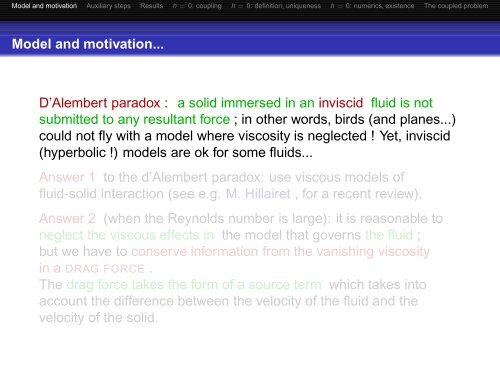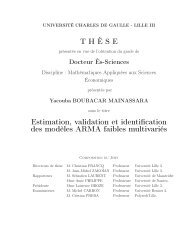A particle-in-Burgers model: theory and numerics - Laboratoire de ...
A particle-in-Burgers model: theory and numerics - Laboratoire de ...
A particle-in-Burgers model: theory and numerics - Laboratoire de ...
You also want an ePaper? Increase the reach of your titles
YUMPU automatically turns print PDFs into web optimized ePapers that Google loves.
Mo<strong>de</strong>l <strong>and</strong> motivation Auxiliary steps Results h = 0: coupl<strong>in</strong>g h = 0: <strong>de</strong>f<strong>in</strong>ition, uniqueness h = 0: <strong>numerics</strong>, existence The coupled problem<br />
Mo<strong>de</strong>l <strong>and</strong> motivation...<br />
D’Alembert paradox : a solid immersed <strong>in</strong> an <strong>in</strong>viscid fluid is not<br />
submitted to any resultant force ; <strong>in</strong> other words, birds (<strong>and</strong> planes...)<br />
could not fly with a <strong>mo<strong>de</strong>l</strong> where viscosity is neglected ! Yet, <strong>in</strong>viscid<br />
(hyperbolic !) <strong>mo<strong>de</strong>l</strong>s are ok for some fluids...<br />
Answer 1 to the d’Alembert paradox: use viscous <strong>mo<strong>de</strong>l</strong>s of<br />
fluid-solid <strong>in</strong>teraction (see e.g. M. Hillairet , for a recent review).<br />
Answer 2 (when the Reynolds number is large): it is reasonable to<br />
neglect the viscous effects <strong>in</strong> the <strong>mo<strong>de</strong>l</strong> that governs the fluid ;<br />
but we have to conserve <strong>in</strong>formation from the vanish<strong>in</strong>g viscosity<br />
<strong>in</strong> a DRAG FORCE .<br />
The drag force takes the form of a source term which takes <strong>in</strong>to<br />
account the difference between the velocity of the fluid <strong>and</strong> the<br />
velocity of the solid.
















